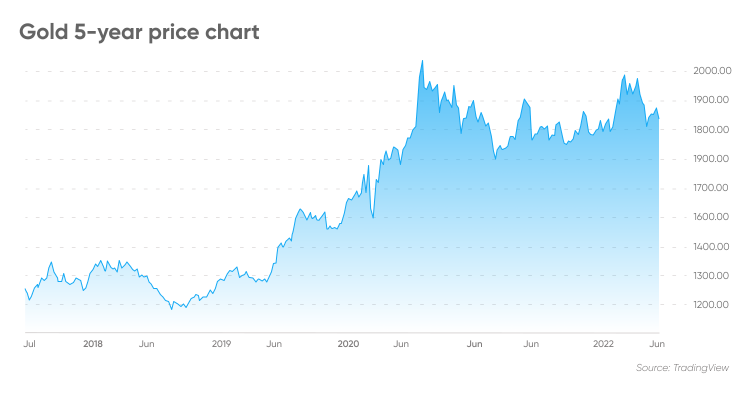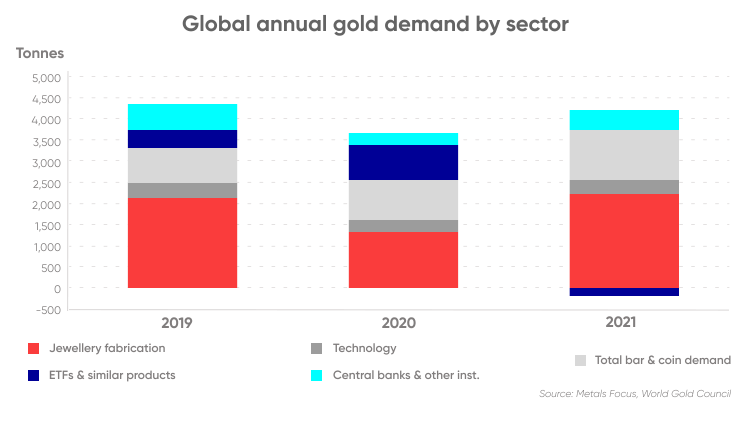(Capital.com, Thurs. July 14th, 2022) – The gold market climbed above the $2,000 an ounce level in March for the first time since August 2020, in response to Russia’s invasion of Ukraine in late February. Geopolitical uncertainty increased the precious metal’s attractiveness for investors seeking a safe haven for their money.
However, gold prices have since retreated to become range bound around $1,725 – $1,900 an ounce as central banks have begun raising interest rates aggressively, increasing returns from interest-bearing assets as alternatives to gold and strengthening the value of the US dollar (USD).
What is the outlook for the gold market? Is gold a good investment in 2022 given these opposing price drivers?
In this article, we look at the different options for investing in gold and the key drivers for the market, as well as some analysts’ views for the future of gold prices.
Gold retreats from strongest rally since 2020 peak
The gold price underperformed analysts’ projections for much of 2021, as expectations of multiple interest rate hikes offset concerns about the economic recovery from the Covid-19 pandemic and high inflation.
Investing in gold is typically considered to be a hedge against inflation, as it retains its value while the buying power of fiat currencies erodes. But it becomes less attractive when interest rates rise, as investors do not receive interest or dividend payments for holding gold.
The gold market came under pressure as the number of rate hikes expected by central banks such as the US Federal Reserve (Fed), European Central Bank (ECB) and the Bank of England (BoE) increased.
Is gold a good investment now? The war in Ukraine has driven up activity on the gold market, with the price climbing from $1,800 an ounce at the start of 2022 to $2,043.30on 8 March – its highest level since it set a record high above $2,070 per ounce in August 2020.

Falling global equity and bond market prices added to gold’s lustre for investors looking for a way to preserve their capital during increased turbulence on the financial markets.
Inflows into gold exchange-traded funds (ETFs) totalled 269 tonnes, equivalent to $17bn during the first quarter of 2022, the highest quarterly total since the third quarter of 2020, while first-quarter US Mint sales of gold coins hit their highest level since 1999, according to the World Gold Council.
The price has retreated in the second quarter, falling back below the $1,900 mark that it has struggled to hold consistently in the past year. Strength in the USD has constrained the gold market, with the Dollar Index (DXY) climbing to a 20-year high in May.
The Fed raised its benchmark interest rate by 0.75 percentage points (pps) on 15 May, its biggest single hike since 1994. This lifted the rate to a 1.5% to 1.7% range, its highest since the start of the Covid-19 pandemic.
What are the main use cases for gold?
Gold is predominantly used in jewellery and as an investment vehicle. Global gold demand totalled 4,021 tonnes in 2021, jumping by 50% during the fourth quarter, according to the World Gold Council.
Jewellery fabrication accounted for 2,220.95 tonnes, with gold bars and coins accounting for 1,180.37 tonnes, central banks and other financial institutions buying 463.07 tonnes and technology applications, such as electroplating in electronics devices, accounting for 330.16 tonnes.
Global holdings in gold ETFs fell by 173 tonnes in 2021 after soaring by a record 874 tonnes in 2020.
Jewellery is also often used as a form of physical investment in gold. That is particularly the case in China and India, the world’s two largest markets, where gold jewellery is given as gifts during festivals and weddings.

How to invest in gold
There are a few different ways traders can invest in gold, depending on how you approach your portfolio.
Gold bullion
One of the advantages of investing in gold as a hedge against inflation and stock market volatility is that you can own the physical metal. Bullion is straightforward to trade and is outside the financial system, making it the ultimate hedge.
You can buy and sell gold bullion in the form of bars, ingots or coins. However, the downside is that owning physical bullion means you need to make sure it is stored securely, requiring you to pay for storage and insurance.
Gold stocks
You can trade on gold prices directly, or you can gain exposure to the market by investing in the stocks of gold mining companies. You can target your stock holdings to certain regions or sectors of the market, as well as specific gold companies.
If you are looking to invest in gold as a long-term portfolio hedge, holding company stocks allows you to keep a position open for years or even decades.
Gold futures
Owning stocks gives you indirect exposure to the commodity markets, but if you want to trade directly on gold price fluctuations, futures markets closely track prices. Gold futures contracts trade on commodities exchanges and allow investors to speculate on the short-term direction of the gold price.
The buyer of a futures contract agrees to take delivery of a certain amount of gold at a set price on the date of expiry.
There are three main regional markets for gold futures: the over-the-counter (OTC) market between dealers, brokers and banks in London, the Commodity Exchange (COMEX) in the US and the Shanghai Gold Exchange in China.
To trade gold futures, you’ll need a brokerage account that will approve access to futures contracts.
Exchange-traded funds (ETFs)
Using ETFs to invest in the gold market offers the convenience of trading company stocks while providing exposure to gold prices. Sector ETFs enable you to gain diversified exposure to a range of companies without having to research each company’s performance.
If you want closer exposure to gold prices you can invest in an ETF that tracks prices. ETFs such as the SPDR Gold Trust follow the price of gold and are backed by physical metal. A unit of an ETF is equivalent to one gram of gold.
Is gold a good investment?
Gold has served as a long-term store of value for thousands of years and has often been used as a form of payment. Many investors opt to hold different amounts of gold in their portfolios. The value in a form of gold, whether physical bars and coins or instruments such as ETFs, is to diversify their holdings and hedge against crashes in the value of stocks and bonds. Note : The physical ownership of gold has won out recently as investors rush to buy coins & bars exhausting the current U.S. Mint’s stockpiles while setting records in the process.
The gold price tends to move in an inverse direction to the US dollar, making it a potential hedge against a decline in the relative value of the world’s reserve currency. It also tends to gain value as an investment during inflation and periods of uncertainty driven by geopolitical instability or other global events.
While other precious metals are also used as portfolio hedges, the gold market has the advantage of the highest liquidity. That could allow investors to quickly exchange their gold for cash at any time. Buying gold online has become increasingly accessible for investors.
Physical gold jewellery, coins and bars are a way for investors to pass on their wealth as an inheritance, as an alternative to holding gold stocks.
Risks of gold investing
However, when considering the answer to the question ‘is gold a good investment?’, it is important to keep in mind that just like any other financial asset, gold comes with its risks and downsides. No market can be called ‘safe’.
Gold does not produce income like interest-bearing savings accounts and dividend stocks, so the total return on an investment can lag these assets over time. High gold price volatility means that there is no guarantee the price will be higher after holding an investment for an extended period.
Gold prices are strongly influenced by central bank policies on inflation and interest rates, which can change at any time.
Always make sure to do your own research before investing in any asset. And never invest money that you cannot afford to lose.
What is the future for the gold price?

Is gold a good investment right now? The geopolitical and macroeconomic outlook has changed investors’ calculations when it comes to the potential for the gold price in 2022.
Analysts at Australian bank ANZ noted:
Analysts at precious metals producer and trader Heraeus emphasised the importance of monetary policy and macroeconomic performance on the outlook for gold:
The Heraeus report added:
When considering if it is a good time to buy gold, it’s important to remember that financial markets remain extremely volatile, making it difficult to accurately predict what the gold price will be in a few hours, and even harder to give long-term estimates. As such, analysts can and do get their predictions wrong. Many experts feel however that the overall performance of gold is set to reveal itself very soon as the U.S. Fed is out of options with U.S. Debt now a colossal $30 trillion + and rising.
Posted by :
Jack Dempsey, President
401 Gold Consultants LLC
jdemp2003@gmail.com

